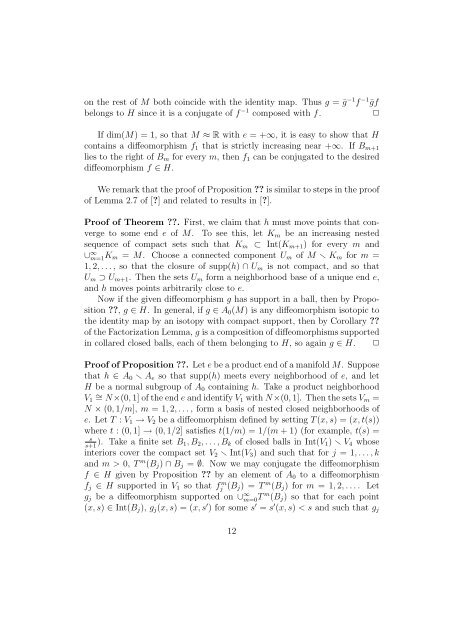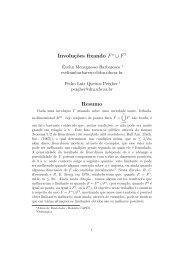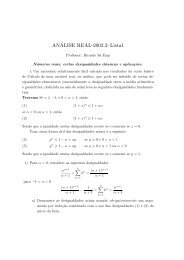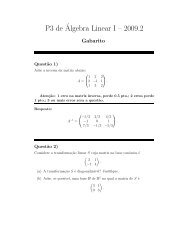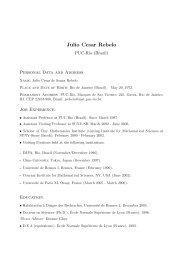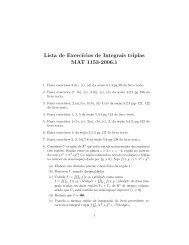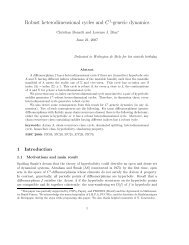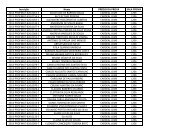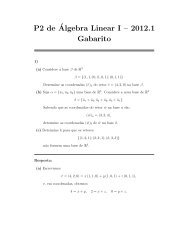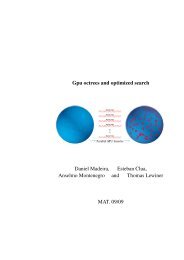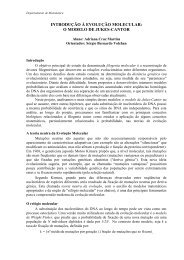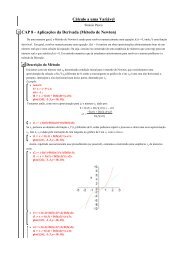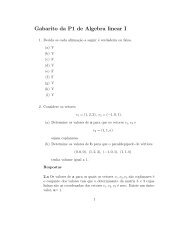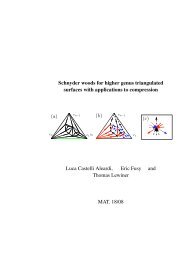NORMAL SUBGROUPS OF DIFFEOMORPHISM AND ...
NORMAL SUBGROUPS OF DIFFEOMORPHISM AND ...
NORMAL SUBGROUPS OF DIFFEOMORPHISM AND ...
Create successful ePaper yourself
Turn your PDF publications into a flip-book with our unique Google optimized e-Paper software.
on the rest of M both coincide with the identity map. Thus g = ḡ −1 f −1 ḡf<br />
belongs to H since it is a conjugate of f −1 composed with f.<br />
✷<br />
If dim(M) = 1, so that M ≈ R with e = +∞, it is easy to show that H<br />
contains a diffeomorphism f 1 that is strictly increasing near +∞. If B m+1<br />
lies to the right of B m for every m, then f 1 can be conjugated to the desired<br />
diffeomorphism f ∈ H.<br />
We remark that the proof of Proposition ?? is similar to steps in the proof<br />
of Lemma 2.7 of [?] and related to results in [?].<br />
Proof of Theorem ??. First, we claim that h must move points that converge<br />
to some end e of M. To see this, let K m be an increasing nested<br />
sequence of compact sets such that K m ⊂ Int(K m+1 ) for every m and<br />
∪ ∞ m=1K m = M. Choose a connected component U m of M K m for m =<br />
1, 2, . . . , so that the closure of supp(h) ∩ U m is not compact, and so that<br />
U m ⊃ U m+1 . Then the sets U m form a neighborhood base of a unique end e,<br />
and h moves points arbitrarily close to e.<br />
Now if the given diffeomorphism g has support in a ball, then by Proposition<br />
??, g ∈ H. In general, if g ∈ A 0 (M) is any diffeomorphism isotopic to<br />
the identity map by an isotopy with compact support, then by Corollary ??<br />
of the Factorization Lemma, g is a composition of diffeomorphisms supported<br />
in collared closed balls, each of them belonging to H, so again g ∈ H. ✷<br />
Proof of Proposition ??. Let e be a product end of a manifold M. Suppose<br />
that h ∈ A 0 A e so that supp(h) meets every neighborhood of e, and let<br />
H be a normal subgroup of A 0 containing h. Take a product neighborhood<br />
V 1<br />
∼ = N×(0, 1] of the end e and identify V1 with N×(0, 1]. Then the sets V m =<br />
N × (0, 1/m], m = 1, 2, . . . , form a basis of nested closed neighborhoods of<br />
e. Let T : V 1 → V 2 be a diffeomorphism defined by setting T (x, s) = (x, t(s))<br />
where t : (0, 1] → (0, 1/2] satisfies t(1/m) = 1/(m + 1) (for example, t(s) =<br />
s<br />
). Take a finite set B s+1 1, B 2 , . . . , B k of closed balls in Int(V 1 ) V 4 whose<br />
interiors cover the compact set V 2 Int(V 3 ) and such that for j = 1, . . . , k<br />
and m > 0, T m (B j ) ∩ B j = ∅. Now we may conjugate the diffeomorphism<br />
f ∈ H given by Proposition ?? by an element of A 0 to a diffeomorphism<br />
f j ∈ H supported in V 1 so that fj m (B j ) = T m (B j ) for m = 1, 2, . . . . Let<br />
g j be a diffeomorphism supported on ∪ ∞ m=0T m (B j ) so that for each point<br />
(x, s) ∈ Int(B j ), g j (x, s) = (x, s ′ ) for some s ′ = s ′ (x, s) < s and such that g j<br />
12


